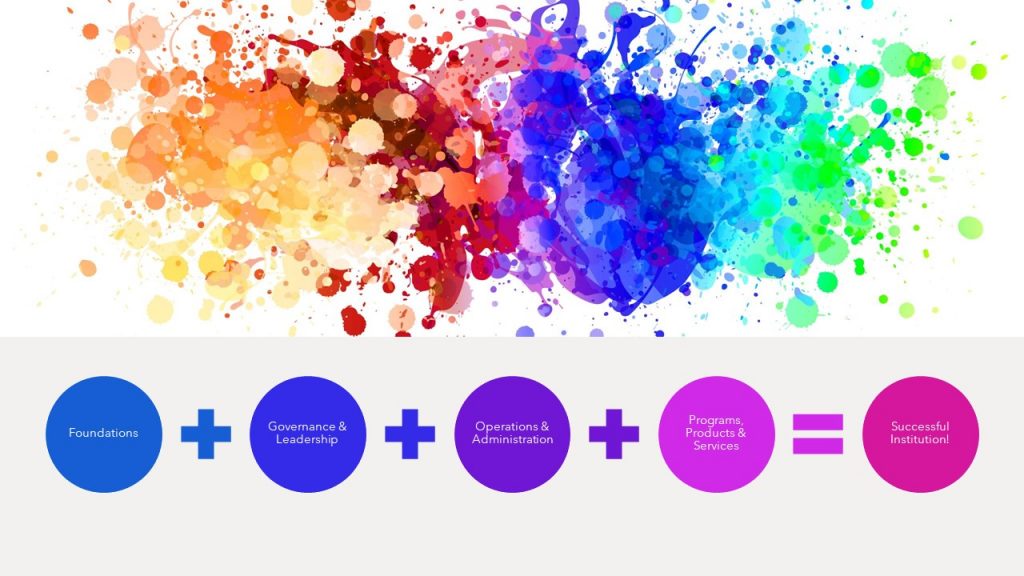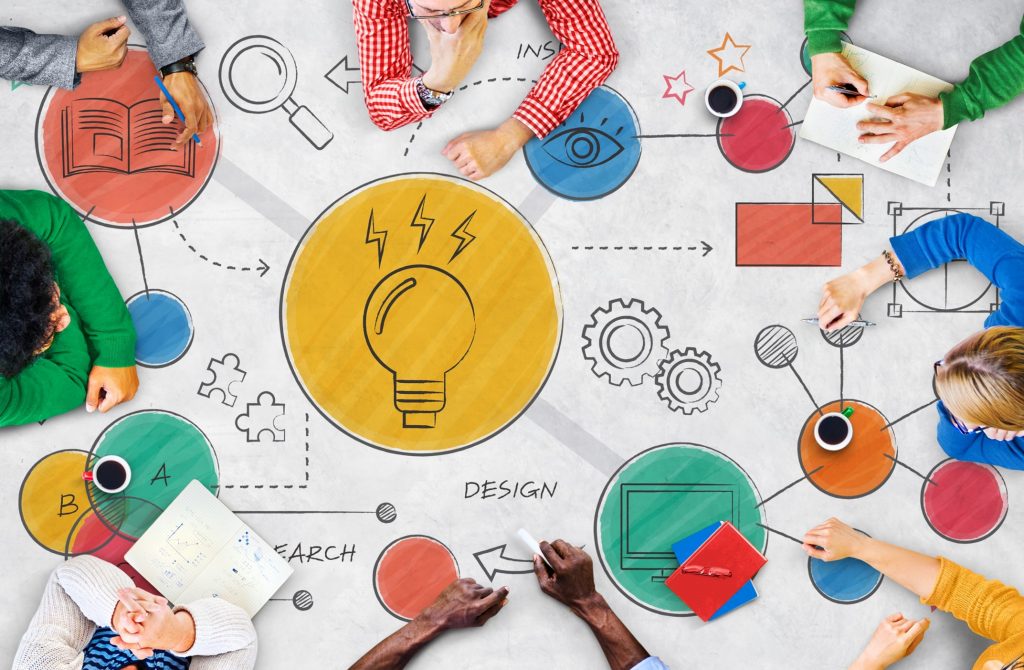Understanding Organizations

Human beings are creators! We have the ability to create concepts and ideas, tools and technologies, systems and processes, and a variety of relationships with other human beings to meet our shared goals. One of our greatest creations is an institution, which can take the form of small and large businesses, nonprofit organizations, or even governments like a city or the United States of America. Institutions combine our ideas, tools and technologies, systems and processes, and working relationships to accomplish a certain mission or task. When we build an organization, business or even a government, we’re “institutionalizing” our concepts, ideas, roles, responsibilities, processes and systems in a single entity.
Universal Purpose
Though it might not seem like it at first, all businesses, nonprofits and governments have a universal mission or purpose. Whether it’s a jewelry store, art collective, trash removal service, or health care agency, the universal purpose of institutions is to empower human beings to reach their own unique highest and fullest potential by addressing an issue, opportunity or problem related to basic human rights or basic human needs in some way. For example, a refrigerator company addresses our need for food and nutrition. A car company addresses our need for transportation. And a homeless shelter addresses our need for safe housing. No matter what we do, or what type of business or organization we have, we’re all working towards a common universal purpose.
Building Blocks of Institutions
Regardless of the organization’s type or mission or purpose, it’s important to know there are four main (4) parts to an institution. To achieve integrity, these parts need to have all of their pieces in place, be aligned with one another, and work towards the universal purpose of institutions. The four main building blocks of institutions include:
Foundations;
Governance & Leadership;
Operations & Administration; and
Programs, Products and Services.

Basic Needs
Businesses and organizations also have basic needs that align with the four (4) parts of institutions. These include:
Foundations
✓ Mission
✓ Vision
✓ Core Beliefs
✓ Guiding Principles
✓ Values
Governance & Leadership
✓ Bylaws/LLC Partner Agreement
✓ Board of Directors Job Descriptions (if applicable)
✓ Decision-Making Processes
✓ CEO/Executive Director Job Description
Operations & Administration
✓ General Administration Items (Name, Phone Number, Email, Address, Hours of
Operation)
✓ Human Resources Plan
✓ Budget, Finance and Accounting Policies (Basic) + Articles of
Incorporation, EIN, 501(c)3
✓ Fundraising, Revenue & Development Plan
✓ Marketing & Outreach Outline
✓ Media & Press
Programs, Products & Services
✓ Summary
✓ Details
When these needs are met, most organizations and businesses can fully thrive! When any of these basic needs are not met, businesses and organizations tend to stagnate, decline or even close down. In addition, when these needs are not in alignment with the organization’s mission or the universal purpose of businesses and organizations, it can cause hardship for managers, employees, volunteers, customers, clients and even the community-at-large.
Understanding Human Beings
It’s really all about people. Understanding some basic things about people can help you make sure you’re building a business or organization that works for everyone it is intended to serve. Recognizing that human beings are the building blocks of all institutions helps us to build healthy businesses and organizations that work for everyone – from the customers to the employees. Just like institutions – including small businesses, nonprofits and government agencies – human beings have a universal purpose, building blocks, and basic needs, too.
Universal Purpose
Human beings often share some pretty common questions – Where did we come from? What is the meaning of life? Spiritual leaders, philosophers, scientists, and many others have worked to help answer these questions. But today most people can agree there is a universal purpose to human life; That purpose is for each one of us to reach our own unique highest and fullest potential – and we each have the ability to define ourselves and what “highest and fullest potential” means to us.
Whether we’re selling jewelry, serving vulnerable populations, or helping people manage their finances, it’s always important to remember we’re helping people to reach their best selves. We want that for our customers and clients, as well as our team members and ourselves.
Building Blocks
Understanding the building blocks of human beings can help us as we develop our policies our systems. We may consider how our paperwork requirements impact those with mental health or cognitive challenges, or how our paid-time-off policies impact people who are caregivers for their parents or children. Understanding people helps us to create better policies and systems, and ultimately, more successful organizations.
Essentially, human beings are made of three (3) basic building blocks. These are most commonly known as the body, mind and soul. The body is our physical self. It’s made up of molecules, bones, muscles, organs, tissues and other matter all operating together so that we can experience life on Earth. Our mind is our cognitive or thinking self. It allows us to process the experiences we have, and guides our thoughts, actions and behaviors. Our soul, or emotional self, is our ability to feel and sense the world around us. It is our energetic connection to all other human beings, and all other living beings in the universe.
Universal Human Rights
As human beings, we’re each endowed with universal human rights. We want to make sure we honor these basic human rights throughout every aspect of our business or organization, including the policies we develop. These universal human rights include:
Dignity and Worth
Human beings have inherent dignity and worth regardless of their perception of themselves or the perception of others. This means all people have the right to be treated with basic dignity and respect in all situations.
Bodily Autonomy
Human beings each have complete ownership of their own body, mind and soul. No one has the right to make decisions about another person’s body, mind or soul without their explicit consent. Explicit consent means they agree to something free from coercion, manipulation, exploitation, or threats of violence or removal of basic needs, such as food, water, housing, employment, or access to public accommodations.
Right to Life
From the moment of birth, every human being has the right to exist. No one has the right to intentionally end another person’s life. Even if other human beings pass laws that try to make it okay to intentionally take someone else’s life, it doesn’t mean these laws are okay.
Right to Liberty
Inalienable rights do not come from other people or groups or even the government. They are inherent to all human beings from the moment of birth. Each person is a free and autonomous being. All people have the right to liberty and freedom. This means all people have the right to experience life, grow, learn and contribute to the world around them in ways that are meaningful to them.
Right to the Pursuit of Happiness
All people have the right to the “pursuit of happiness”. This means all people have the right to explore, identify and do that which brings them joy, peace, and contentment. It’s their life.
Basic Survival Needs
When we’re building businesses or organizations, it’s also important to take into account basic human needs, human development and learning, and basic human responses. Specifically, when our basic needs are not being met, human responses can range from illness and death, to lashing out, protesting or even “criminal behaviors”. Generally speaking, people need:
- A sense of hope and opportunity;
- Clean, breathable air;
- Stable, secure housing that includes basic protection from the environment and other dangers, and also includes appropriate heating, air conditioning, food preparation and storage facilities (like a refrigerator, freezer and stove), restroom facilities for going to the bathroom and bathing, and running water;
- Clean, drinkable water;
- Healthy and adequate food and nutrition;
- The right amount of sleep in a stable, safe condition that allows for physical rejuvenation and mental and emotional processing;
- Stimulating physical, mental and emotional activity (such as running, playing sports, reading, writing poetry or working on hobbies); and
- Access to preventative and emergency medical and mental health care education and services.
(Note: This information was adapted from Abraham Maslow’s Hierarchy of Needs and the Whole Person Centered Optimal Health and Wellness Model.)
Sense of Self, Environment and Relational Needs
In addition to our basic survival needs, people also have basic needs that are related to their sense of self and well-being, their environment, and their relationship to others.
Specifically:
- We need a sense of physical, emotional, spiritual, mental, and financial safety and security.
- We need a sense of justice and fairness in the rules and systems we interact with.
- We need a set of personal boundaries or guiding principles that allow us explore the world without causing harm to ourselves or others.
- We need an understanding of our own body, mind and soul, as well the opportunity to explore and determine our own abilities, capacities, beliefs, cultural traditions, and things that we enjoy.
- We need gratification and entertainment.
- We need the ability to stand up for and defend ourselves in ways that cause no harm or the least amount of physical, mental or emotional harm to others.
- We need access to new and complete information, opportunities, education and experiences.
- We need access to transportation and mobility options (including wheelchairs, bicycles and sidewalks) that allow us to connect with resources, opportunities, communities and activities both far and near.
- We need the ability to contribute our own experiences, knowledge, skills and talents to in ways that are meaningful to ourselves, such as through work or employment, school, volunteering, raising a family, playing a sport, or participating in an online chat forum.
- We need the ability to give and receive consenting affection (positive, non-sexual touch) to ourselves and others, such as through hugs, pats on the back, holding hands, or even petting or holding an animal like a dog or cat.
- And we need the ability to: provide self-affirmation through positive self-talk and encouragement; receive positive affirmation from others; and to provide positive affirmation to others.
Knowing these important things about people can help make sure we’re implementing the best policies for our internal team members, and developing the best programs, products and services for our customers and clients.
A Spectrum-Based View of Human Beings
Just like diversity is critical for biological evolution, diversity of thoughts, experiences and approaches to challenges are critical for healthy organizations. From a business perspective, using the spectrum-based view of humanity can help ensure our business or organization is diverse, accessible and inclusive.
Though we all have the same universal rights and basic needs, human beings come in all shapes and sizes. We have a range of skin colors and hair types, varying heights and weights, ranges of immune system responses and sexual and digestives organs, and many other universal traits we share in common, but are individually unique. We have different gender expressions and sexual orientations, religious and spiritual beliefs, physical, cognitive and emotional abilities, and different languages and cultural traditions – But the important thing is that we each have them.
In healthy organizations, the goal is always to ensure our business or organization is accessible to, inclusive of, and reflective of the diversity of all human beings. Using a spectrum or continuum-based lens that recognizes the universal characteristics we all have in common – as well as the uniqueness of each of us as individuals – can help us achieve these goals. A spectrum-based view of humanity helps us consider the wide range of human variations by first considering the things we all have in common. These are known as the universal traits. For example, we all have…
- Bodies (with a range of limbs and features)
- Skin tones
- Skin types
- Hair types and hair colors (or absence of)
- Cultural traditions and expressions
- Languages and ways of speaking, communicating or understanding
- Physical ability ranges
- Mental or cognitive ability ranges
- Emotional ability ranges
- Biological sex characteristics, including intersex, those with XX/XY variations, and those with or without the ability to reproduce
- Gender identity or expressions, inclusive of transgender or non-gender specific expressions
- Sexual orientation and relational orientations, including same-sex attraction, opposite sex attraction, multi-sex attraction, and even non-attraction
- Current economic means
As we develop our organization’s components – such our policies, human resources practices, and marketing and outreach – we want to consider the broadest spectrum of humanity based on our shared characteristics. Here are some example questions we might ask:
Will this shampoo product work for the broad range of human skin and hair types, or do we need to make several shampoo products to meet the needs of our customers and clients?
Does our dress code (if we think we need to have one) ensure “professional dress” is inclusive of the range of culturally diverse formal wear and styling?
Does the language we use on our forms recognize the diverse range of family make-ups, including same-gender households, single parent households, grandparents raising children, etc.?
Does our building or meeting space meet the needs of the broad range of physical and mobility capacities, including people who use mobility devices or people of all eyesight ranges?
Do our policies and procedures account for the wide range of emotional and mental capacities, and recognize that strict rules and detail-oriented paperwork limits accessibility?
By using a spectrum-based view of humanity, we can recognize our universal commonalities, while acknowledging, appreciating and incorporating the diversity and experiences of all human beings.

Build & Create
Decide to Organize
An organization, business or program is really just an idea. It doesn’t become an institution until there are people who want to take on the needed roles and responsibilities to bring it to life. And not all ideas need to become a full-blown institution. Some goals can be accomplished by a single person, or through a short-term or time-limited committee or task force. However, if the issue, problem or opportunity you’re trying to address will likely take a long time to accomplish, need human resources beyond yourself, and require external funding, then an organization, small business, or new program is probably the right fit.
Remember: Cooperative Competition
Healthy organizations are designed to add something new to the community, industry or market. They may complement existing services by filling a gap or by providing a new way of doing things. They might also spark cooperative competition simply by adding their own unique spin to what already exists.
Rather than trying to shut another business down, those engaging in cooperative competition enter the market with the idea that good products sell themselves. Other businesses or organizations will be encouraged to raise the bar to stay relevant. Generally speaking, a new business or organization is not designed to take another business down.
Step 1: Building Your Issue Statement
An issue statement is designed to capture the impetus or reason for your business or organization’s existence. It also provides a basic outline of what you hope to accomplish and how. You can use the Issue Statement worksheet to get started.
Open Issue Statement Worksheet
Step 2: Decide Your Organization Structure
Once you’ve decided to institutionalize your idea, it’s time to think about your organization structure. Here are a few of the most common options:
- Sole Proprietorship
- LLC
- Nonprofit Organization
- Fiscally Sponsored Organization
- Program or Department of an Existing Business or Organization
You may want to consult the IRS, your state business licensing office, or an attorney or accountant if you need additional guidance about what’s right for you. You can also learn more from the U.S. Small Business Administration’s organization structure guide.
